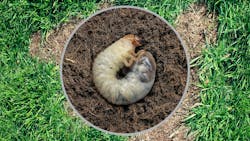Did you know that one female beetle can lay over 200 eggs in a single season? This means a small grub problem can quickly grow into a major infestation. Warmer soil and moist conditions in the Midwest help these eggs hatch and the grubs thrive.
Recent weather patterns of milder winters and wetter springs give grubs a better chance to survive and multiply. As a result, many property managers are noticing more grubs in their lawns than ever before.
What Are Grubs and Why Should You Care?
Grubs are the larval stage of various beetle species, such as Japanese beetles and June bugs. They live in your soil where they feed on the roots of grass. These small, C-shaped creatures can go unnoticed until significant damage is done to your lawn. When grubs are left unchecked, they can create brown, dying patches in lawns that look unsightly and compromise the health of your turf.
In addition to damaging the aesthetics of your property, grub infestations can lead to weakened lawns that are more susceptible to erosion and other environmental stresses.
Grubs cause so much harm because they target the root system of your grass, which is essential for water uptake and nutrient absorption. Without healthy roots, lawns struggle to survive. This is especially true during the hot, dry periods of summer.
Signs of a Grub Infestation
It is not always obvious that grubs are at work until you start to see signs of damage. If you are a property manager, you should be on the lookout for several common indicators like:
- Developing patches of brown or yellow grass in clusters
- Thinning soil
- White or off-white grubs among roots
- Increase in bird activity
The spring and summer weather offers a fertile environment for these pests due to the warm and moist soil conditions. Recognizing the early signs of grub damage is essential because it can help you take immediate action before the infestation spreads and causes even more extensive damage.
Once you notice these dead patches or thinning grass, it is often too late to reverse the damage on your own, which is why early detection and treatment are critical.
How to Get Rid of Grubs
Many of our clients have expressed frustration at trying to manage grub infestations on their own, only to find that home remedies and off-the-shelf products are not sufficient to eliminate the problem.
Home remedies can offer a natural way for you to tackle grubs on your own if you have only a small infestation. A more natural approach involves attracting more birds with a bird feeder, and watching how much you water your lawn, as grubs love a moist environment.
Many homeowners have found that applying beneficial nematodes to their lawns works well because these microscopic worms seek out and naturally infect grubs in the soil. You can buy these nematodes at garden centers or online and simply water them into your lawn during early spring when grubs are most vulnerable.
Some people also try using milky spore, a naturally occurring bacteria that can help reduce grub populations over time. There are even recipes for a soapy water mixture or organic sprays made with neem oil that some claim can disturb grub activity, though these methods may not always produce consistent results.
It is important to note that these home remedies work best when combined with regular lawn care practices such as fertilizing, dethatching, and aeration to promote strong grass that can better withstand pest damage.
While these DIY solutions can provide temporary relief, monitoring your lawn closely and addressing any signs of damage early is key to preventing a full-blown infestation. For persistent issues or larger properties, many still opt for professional services to ensure complete control and lasting results.
Preventing Future Infestations
Once you have addressed a grub infestation, the next step is to ensure that it does not come back. Prevention is key, and there are several strategies that you can implement to keep your lawn healthy and free from pests.
Regular lawn maintenance is the cornerstone of prevention. This includes proper mowing, watering, and fertilizing practices that promote a strong, resilient turf. A healthy lawn is naturally more resistant to pest invasions because robust grass roots are less likely to be overrun by grubs.
In addition to routine care, consider integrating organic methods into your lawn care regimen. As mentioned, encouraging the presence of beneficial insects and birds can help control grub populations naturally. Some property managers have found success with the introduction of nematodes, microscopic organisms that are natural predators of grubs, into their soil. These organic solutions work alongside professional treatments to create a multi-layered defense against infestations.
Conclusion
In conclusion, grub control is a critical service for property managers who want to maintain the beauty and health of their lawns. Grubs may seem small and harmless, but they can cause significant damage by targeting the roots of your grass, leading to unsightly and weakened lawns. It’s best to find an approach that combines thorough inspections, targeted treatments, and ongoing preventive measures to ensure that your lawn remains robust and healthy. Local landscaping companies can also always offer more tailored advice.
About the Author
Tom Marsan
Tom Marsan is a certified snow professional who has been in the landscaping and snow removal industry for about two decades. He is an active member of ILCA and SIMA and is currently the General Manager at Beverly Companies in Chicagoland.
